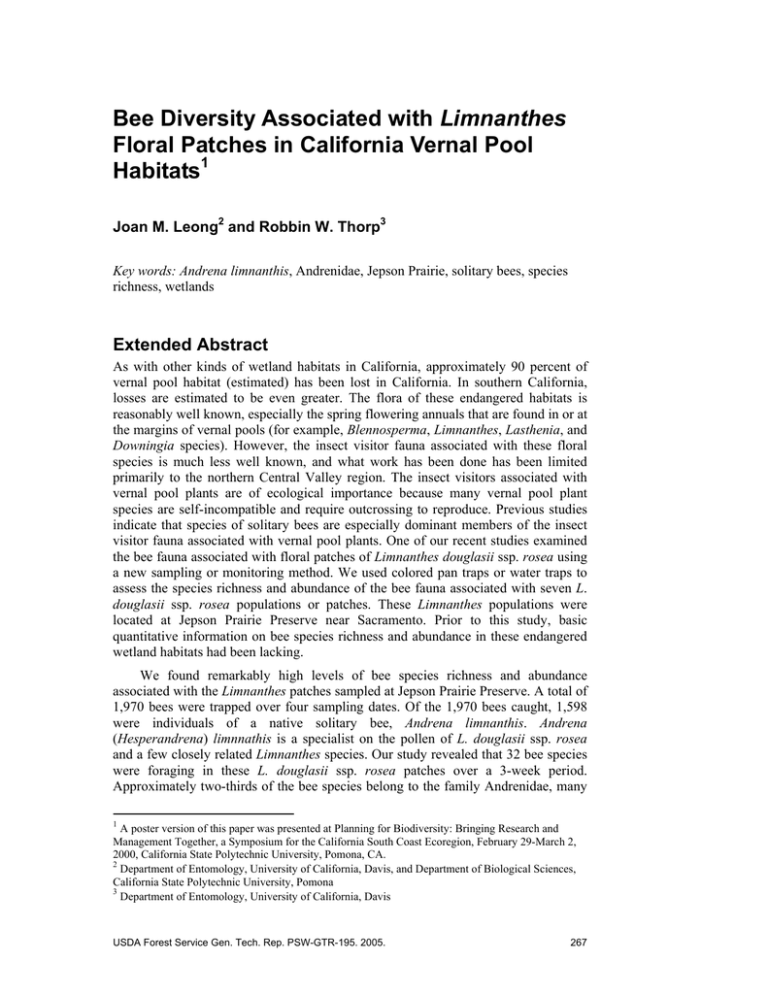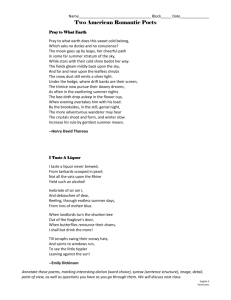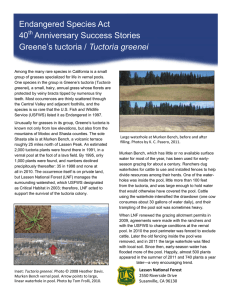Limnanthes Floral Patches in California Vernal Pool Habitats Extended Abstract
advertisement

Bee Diversity Associated with Limnanthes Floral Patches in California Vernal Pool Habitats1 Joan M. Leong2 and Robbin W. Thorp3 Key words: Andrena limnanthis, Andrenidae, Jepson Prairie, solitary bees, species richness, wetlands Extended Abstract As with other kinds of wetland habitats in California, approximately 90 percent of vernal pool habitat (estimated) has been lost in California. In southern California, losses are estimated to be even greater. The flora of these endangered habitats is reasonably well known, especially the spring flowering annuals that are found in or at the margins of vernal pools (for example, Blennosperma, Limnanthes, Lasthenia, and Downingia species). However, the insect visitor fauna associated with these floral species is much less well known, and what work has been done has been limited primarily to the northern Central Valley region. The insect visitors associated with vernal pool plants are of ecological importance because many vernal pool plant species are self-incompatible and require outcrossing to reproduce. Previous studies indicate that species of solitary bees are especially dominant members of the insect visitor fauna associated with vernal pool plants. One of our recent studies examined the bee fauna associated with floral patches of Limnanthes douglasii ssp. rosea using a new sampling or monitoring method. We used colored pan traps or water traps to assess the species richness and abundance of the bee fauna associated with seven L. douglasii ssp. rosea populations or patches. These Limnanthes populations were located at Jepson Prairie Preserve near Sacramento. Prior to this study, basic quantitative information on bee species richness and abundance in these endangered wetland habitats had been lacking. We found remarkably high levels of bee species richness and abundance associated with the Limnanthes patches sampled at Jepson Prairie Preserve. A total of 1,970 bees were trapped over four sampling dates. Of the 1,970 bees caught, 1,598 were individuals of a native solitary bee, Andrena limnanthis. Andrena (Hesperandrena) limnnathis is a specialist on the pollen of L. douglasii ssp. rosea and a few closely related Limnanthes species. Our study revealed that 32 bee species were foraging in these L. douglasii ssp. rosea patches over a 3-week period. Approximately two-thirds of the bee species belong to the family Andrenidae, many 1 A poster version of this paper was presented at Planning for Biodiversity: Bringing Research and Management Together, a Symposium for the California South Coast Ecoregion, February 29-March 2, 2000, California State Polytechnic University, Pomona, CA. 2 Department of Entomology, University of California, Davis, and Department of Biological Sciences, California State Polytechnic University, Pomona 3 Department of Entomology, University of California, Davis USDA Forest Service Gen. Tech. Rep. PSW-GTR-195. 2005. 267 Poster Session—Bee Diversity in Vernal Pool Habitat—Leong and Thorp of which are thought to be endemic to vernal pool habitats. The mean number of bees caught per sampling unit, averaged over patches and dates, was 118.8 ± 20 SE (standard error), range 32-283. The mean number of bee species caught per sampling unit, averaged over patches and dates, was 9.3 ± 0.8 SE, range 5-18. The number of A. limnanthis individuals and the number of bee species with intermediate levels of abundance was higher than expected. The shape of the bee species abundance curve was most similar to the log series or lognormal theoretical species abundance models. These results suggest that the diversity of vernal pool plant visitors may be underrated by most wetland ecologists and professionals. Many of the same vernal pool plants that host a variety of oligolectic or specialist bees and non-oligolectic bees in central and northern areas are also found in southern California vernal pool habitats. Thus, we propose that a similar level of bee diversity may occur in southern California vernal pool habitats. Because surprisingly little is known from these southern areas, we recommend that similar studies of the bee fauna of southern California vernal pool habitats be undertaken. Our results here will provide baseline data for future monitoring efforts. Such information is critical to biologically informed decisions involving the conservation and restoration of biodiversity in the remaining vernal pool habitats in California. 268 USDA Forest Service Gen. Tech. Rep. PSW-GTR-195. 2005.








